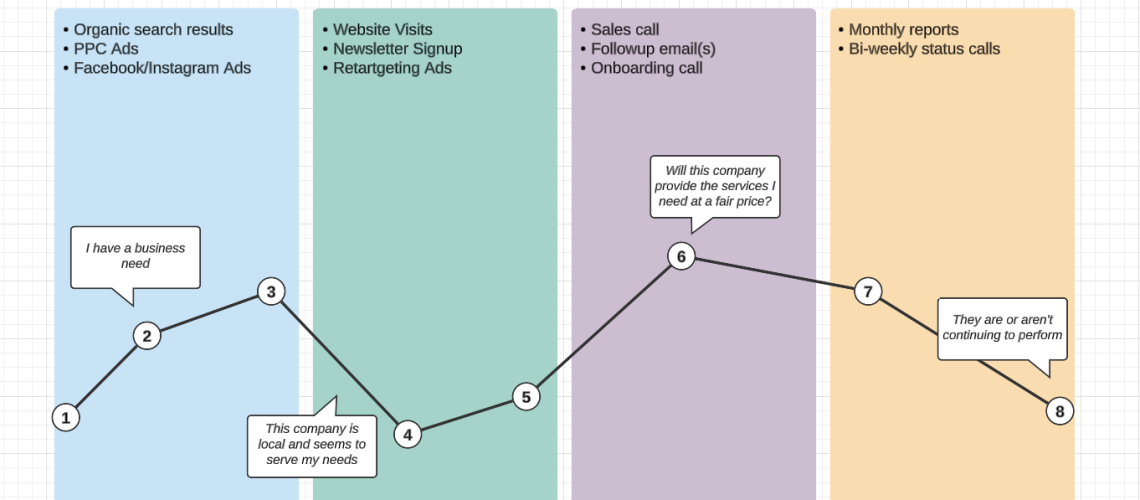In an increasingly customer-centric world, businesses need to understand their customers’ experiences intimately to deliver personalized, high-value interactions. Enter the concept of Customer Journey Mapping — an essential tool to visualize and understand your customer’s experience from initial contact through to long-term engagement. Let’s delve deeper into what a customer journey map is and how it can be used to improve your marketing strategy.
What is a Customer Journey Map?
A customer journey map is a visual representation of the process that a customer goes through when interacting with a company. It starts from the customer’s initial awareness of the company or product and goes all the way through to purchase and beyond, often including post-purchase activities like support or advocacy.
Each company’s customer journey map will look a little bit different, even compared to a different company within the same industry.
The journey map shows the customer’s motivations, goals, and pain points at each stage of the journey, providing a comprehensive view of the customer’s experience. It usually involves multiple touchpoints across different channels — including your website, social media, email, and even phone conversations.
Why is a Customer Journey Map Important?
Customer journey maps allow businesses to gain deep insights into their customers’ needs, feelings, motivations, and obstacles. By understanding these key elements, businesses can design a better customer experience and build stronger relationships with their customers.
More specifically, customer journey mapping helps businesses to:
-
- Identify gaps or bottlenecks where customers are getting frustrated.
-
- Understand the customer’s perspective and their decision-making process.
-
- Reveal opportunities to create a more streamlined, satisfying customer experience.
-
- Align the organization around a shared understanding of the customer journey.
How to Create a Customer Journey Map?
Creating a customer journey map can seem like a daunting task, but with these steps, you can build a comprehensive map to enhance your marketing strategies:
1. Define your buyer personas: The first step is to know who your customers are. You can create buyer personas by researching and segmenting your target audience based on demographics, behavior patterns, motivations, and goals.
2. Identify touchpoints: Touchpoints are the interactions your customer has with your brand. This could be anything from seeing a Facebook ad, visiting your website, receiving an email newsletter, to speaking with customer service.
3. Map out the customer journey for each persona: Identify the stages each persona goes through in their journey with your brand. The stages could include awareness, consideration, purchase, retention, and advocacy.
4. Identify customer emotions, motivations, and pain points at each stage: Understand what your customers are feeling, what motivates them, and what issues they’re facing at each stage of the journey.
5. Review and refine: Customer journey maps should be living documents that evolve with your understanding of your customers and the market. Regularly review and update your map as needed.
Using Customer Journey Mapping to Improve Your Marketing Strategy
Understanding your customer journey can directly influence your marketing strategy in several ways:
Personalization: Once you understand the stages of the customer journey, you can deliver personalized messaging and content that resonate with your customers at each stage.
Improved Customer Experience: By identifying the pain points in the customer journey, you can work to remove these obstacles and provide a better overall customer experience.
Greater Customer Retention: A seamless customer journey fosters loyalty. By making sure your customers are satisfied at every step, you can increase the chances of them returning and recommending your brand to others.
Identify Opportunities: Journey maps can help you spot opportunities to introduce new products or services based on your customers’ needs and expectations.
Customer Journey Mapping Tools
- UXPressia is a cloud-based customer experience management platform that helps teams to visualize, share, present, and improve their customer journeys. It offers a wide range of features, including drag-and-drop interface, insights and data point libraries, color-coding on cards to depict customer emotions, and the possibility to add external links and text to your maps.
- Lucidchart offers a variety of templates and features, making it easy to create and share customer journey maps. Lucidchart also integrates with other tools, such as Google Drive and Slack, making it easy to collaborate on customer journey maps.
- Smaply is a customer journey mapping tool that is specifically designed for small businesses. It offers a wide range of features, including the ability to create multiple persona journey maps, track customer feedback, and measure the effectiveness of your customer journey maps.
In conclusion, a well-crafted customer journey map is a powerful tool for understanding and improving your customers’ experiences. It offers deep insights into customer behavior and expectations, and these insights can be used to enhance your marketing strategy, improve customer satisfaction, and ultimately drive business growth.


